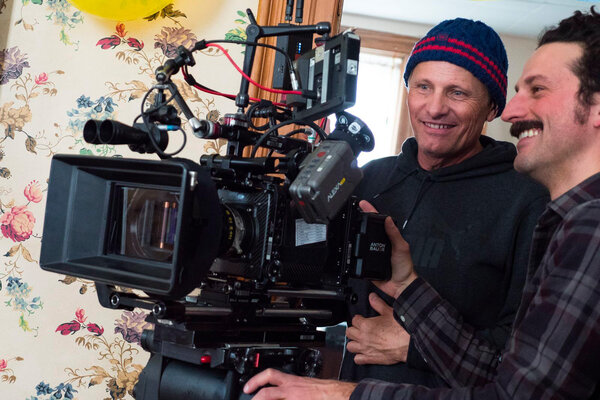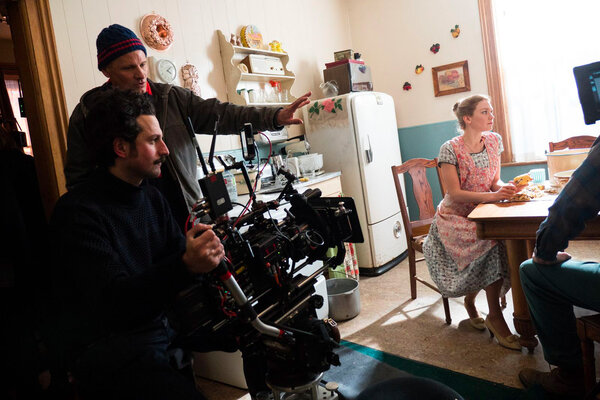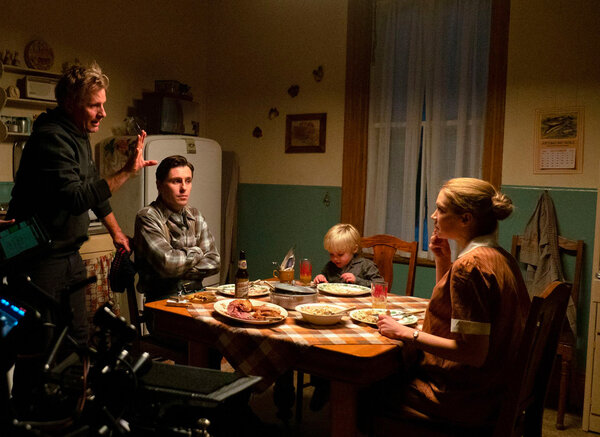Marcel Zyskind, DFF, speaks about his work on "Falling", by Viggo Mortensen
Father’s DayJohn lives in California with his partner Eric and their adopted daughter Mónica, far from the conservative rural life he left years prior. His father, Willis, a stubborn man from a bygone era, now lives alone on the isolated farm where John grew up. Because Willis’s mind is beginning to fade, John takes him along with him out West, in the hope that he and his sister Sarah can find the old man a home closer to theirs. But their good intentions collide with Willis’ staunch refusal to change anything whatsoever about his life...
Can you tell me a bit about how this project was conceived ?
Marcel Zyskind : I met Viggo Mortensen in 2013 on the set of The Two Faces of January for which I was the DoP. Because we both speak Danish (it is one of his two mother tongues), we hit it off very quickly and had long conversations about photography (which is another of the actor’s passions). He also told me about several ideas he had for feature films that he had been preparing for some time, and that he wanted to direct. One of them was the adaptation of a novel called The Horsecatcher, whose main character is a young Cheyenne Indian, who is more passionate about horses than about war or hunting. A very nice script, but not an easy film to shoot, given the children and animals ! The film was struggling to find funding and, in the meantime, Viggo got the opportunity to go to Canada to begin work on Falling, which was another, even more personal project, that he’d written himself. As soon as I read the screenplay, I felt enthusiastic about the film, and I immediately called him as to tell him I was on it – no matter that the budget hadn’t yet been completely finalized...

How did you choose the locations ?
MZ : I remember that we started scouting in Ontario very early on. Since I am lucky enough to have friends who own an equipment rental company in Copenhagen, I was able to easily borrow a camera and a few lenses, and to go around to potential locations. The script relies heavily on memory, and it seemed very important to me to have as many atmospheres as possible for when it came time to edit : different lights, times and seasons. Especially since in Canada, when a film’s shooting schedule is in the middle of winter, it is truly difficult to get anything else than snow !
In any case, generally, and not just on Falling, this seems to me to be one of the major advantages of digital. Now, I always ask to have a camera along with me for reccies on any film I work on. The freedom to travel nearly on one’s own and to bring back shots of places that you’ll perhaps only see once in your life is a real plus. Whether it’s in order to gradually find the style or moods that will be at the heart of your cinematography, or just to provide editors with material that will often be impossible to recreate during filming.
What shots were you able to bring back ?
MZ : Sometimes it was just landscapes filmed from the car window with the Arri Alexa Mini as we moved from one place to another. Other times, it was much more classic landscape shots on a tripod, some of which made it into in the final cut, or were even used as a fake background with the actors on a green screen. Having Carol Spier (Cronenberg’s artistic director) along with us during these reccies was also very useful, as it allowed us to list everything that came to our minds in terms of art design and props. I even remember that Viggo was sometimes able to play his young father’s double (Sverir Gudnason) in some takes when he’s partially out of the frame, such as when he’s coming out of a barn or filmed from behind on a tractor...
In the film, there is a rather strong contrast in tone between the past and the present...
MZ : Generally speaking, our intention was to tend photographically toward warm atmospheres for the past, while the present would be permeated by cold and snow. Naturally, we use the counterpoint of the contemporary scenes shot in California where, even in wintertime, the sun contrasts with the frozen atmospheres in Canada. This decision more-or-less determined the shooting order, given that we knew we’d have to schedule according to when there would be snow on the ground. We also had to consider the change in the set design of the family farm, as we had to go from the 1960s to the present day (mainly in the last part of the film). That’s why we started shooting with the end of the film, in the snow. Then, Carol Spier’s team took care of redecorating the farm so that we could shoot all of the flashbacks, particularly the kitchen, which is a location that we see repeatedly coming back between past and present.


Finally, the last four days of filming were devoted to the Californian part, and in particular to this long family meal in the garden (almost 15 pages of dialogue in the screenplay).
Let’s talk a bit about that scene...
MZ : It wasn’t easy to manage ! Especially because, unlike the rest of the film, this scene had to be shot with two very mobile cameras. As Viggo had decided to use these tracking shots around the characters at the table to accentuate Willis’ feeling of discomfort (Lance Henriksen), it was important to ensure continuity from take to take, especially concerning the timing of the lines. In order to capture the moment, I remember re-watching the opening sequence of Reservoir Dogs, with its famous monologue on Madonna. That was exactly the idea I was going for, with a circular tracking shot and the camera stopping at a certain point, only to start again in the opposite direction. This is the only scene I used camera operators for. It allowed me to take a step back and to pay even closer attention to continuity and to the lighting.
This film was shot in anamorphic. Why this choice ?
MZ : Although this film is obviously much more of a character driven movie than a landscape or ambience film, it seemed right to me to shoot it in anamorphic, mostly in order to erase the slight flatness of filming in spherical. I wouldn’t use the term “more cinematic”, which advertising agencies love, but rather the feeling of being in a slightly different reality...
I take it to be evident that ever since the birth of digital cinematography, anamorphic is once again getting the recognition from filmmakers that it did from the golden age of cinema up to the 1990s. Maybe it’s because people have a bit of nostalgia for the time when we still shot on film ? One thing is certain, that from a purely practical point of view, I didn’t make things easier for myself by shooting this film in Scope. Especially because sometimes there are simultaneously children and adults present in the frame, which, in anamorphic, always creates problems with managing the height of the frame, and therefore, sometimes, overly-wide shots...
What lenses did you choose ?
MZ : Panavision Toronto provided me with the excellent G series that was used for most of the film. In addition, I had two zooms (37-85mm and 70-200mm) for scenes where the acting was a bit complicated, such as in the Thai restaurant or for the meal in the garden I just mentioned. When filming the bits of the film that took place in the past, I went for a vintage Lomo series, as well as a few modern Atlas Orion lenses.
What brand is that ?
MZ : It’s a new brand, co-founded by American cinematographer Dan Kanes. They’re lenses whose look is a bit more modern than the Lomo series, but above all they’re radically different in their mechanical design, which makes them much easier to use. I like these lenses since, like the Panavision G series, they provide a bit of distortion, but not too much.
Another fairly long dialogue sequence between two actors takes place at night in John’s kitchen, with the bottle of whisky…
MZ : That’s really the first big scene between the two main characters in the present. Given the length of the scene, of course, you wonder what you can do with the camera to make it feel a bit more dynamic. There was no question of making camera movements (as in the scene with the meal in the garden), so we decided to split the scene into three parts. We crossed over into the other side of the eyeline on the second part, and we ended with full-frontal close-ups in the middle section. Then, at the end we returned to the original shot reverse shot eyeline position, but with a slightly lower camera height and a slightly lowered camera angle. In parallel – and you might not even notice it when you watch it the first time – I decided to gradually darken the background of the apartment in order to leave the characters alone against a background of darkness at the end of the scene. This isn’t a striking effect, but rather a slight touch here and there where we gradually turn off a few prop lights without drawing the viewer’s attention…
There is a scene in the past where the mother leaves the farm and takes her children with her. It takes place in the front hall of the farmhouse with a very gray exterior day background. An almost twilight atmosphere...
MZ : It’s funny that you chose to talk about this scene ... because it’s one I’m not totally happy with ! Personally, I find the characters a little too over lit. In fact, I had to fight a bit with this scene, where the light is supposed to come almost only from the front door in a rather narrow front hallway with the characters nearly glued to the walls… Since the front porch was so deep, it was simply impossible for me to bring in a single source from outside without its being seen in the frame. So, I had to cheat by hanging a sort of Kino LED above the actors. To my eye, it still looks like artificial lighting, even though we tried to make it as soft and natural as possible, and even dimmed it in color grading ... But we couldn’t alter it too much in post without it becoming a dull grey. In addition, the door opens at the end of the scene, so we had to find the right contrast ratio between the start and the end of the scene... really not easy to do !
And also, when you’re filming scenes like that, where children are acting, you’re focused on their performance…and you don’t notice everything. In any case, filming actors glued against the walls is a famously difficult situation for a DoP. Just like filming someone lying in bed… you constantly find yourself stuck in that type of situation. But since this type of scene sometimes reoccurs on another film you’re working on, you end up learning from your mistakes and then sometimes, with hindsight, you end up liking what you didn’t like at the time. It’s funny to see how we change as moviemakers on these very basic questions.
What are you the proudest of on Falling ?
MZ : This is the first time that I’ve ever shot with a director who also plays one of the main roles. Basically, I don’t think Viggo necessarily wanted to play John, but of course, it was much simpler to fund the movie if he did... It was a real challenge and added an extra layer to my work. Since Viggo isn’t a fan of reviewing every take on the video feedback, and sometimes he simply doesn’t have the time, so sometimes, because we often took very long takes, I had the responsibility of deciding whether we needed to do another take or not. I am very proud of having worked with him and that he placed his trust in me on this project.
(Interview by François Reumont on behalf of the AFC, and translated by A. Baron-Raiffe)
- Falling is due to be released on November 4 in Paris and will be screened at the opening of the 28th edition of the EnergaCamerimage festival, to be held from November 14 to 21, 2020, in Toruń, Poland.
Screenplay and directing : Viggo Mortensen
Production : Daniel Bekerman, Chris Curling
DoP : Marcel Zyskind, DFF
Production Designer : Carol Spier
Editor : Ronald Sanders
Sound : Paul Gosse (Sound mixer)
- Official trailer (VOSTF) :
 En
En Fr
Fr




